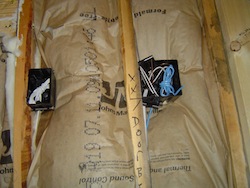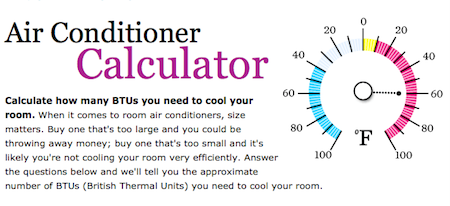Sex Advice, Diet Tips, Decorating Ideas, & HVAC Design

Spice up your relationship with these seven sexy suggestions! Give your skin the youthful glow of radiant good health! Master that new mixer with these garden fresh recipes! Calculate the number of BTUs per hour that your home needs for air conditioning!
Yes, Good Housekeeping has heard the call for a simpler way to size air conditioners than by using Manual J, the tedious load calculation protocol from the Air Conditioning Contractors of America (ACCA). Alongside their sex advice, diet tips, and decorating ideas, you can now find a handy-dandy Air Conditioner Calculator. [Update, 7/24/18: They seem to have removed the calculator.] Just enter a few bits of information about your home, hit the Calculate button, and there’s the number telling you what size air conditioner you need.
Some of the inputs include:
- Color scheme for the room: Effusive Dandelion, Analogous Aroma, Killer Paisely, or Plain Old Boring
- Eating preferences: Gourmet Chef, Right Out of the Box, or Always Eat Out
- Parenting style: BFF, Concerted Cultivation, What Kids?, or Attila the Hun
Well, OK, I totally made up the inputs there, but you could hardly do worse using a calculator based on those rather than the one they have on their site. The actual inputs you find there consist of 4 questions, two with drop-down menus and two with yes-no buttons. They are:
- Square footage of room: Drop-down menu has 7 choices with ranges between 100 and 1000 square feet.
- “How is the room insulation?” Excellent, Very Good, Average, Poor, or None
- Is the room very sunny? Yes or no.
- Is the air conditioner for the kitchen? Yes or no.
A look at the results
Just based on the minimal inputs, you can probably tell that the results won’t be very accurate, but let’s take a look. On one end of the rather small spectrum, we have a small sunny kitchen with no insulation. At 100 square feet, the cooling loading that the Good Housekeeping calculator came up with was 13,900 BTUs per hour. That calculates out to an abysmal 86 square feet per ton of air conditioning capacity. (A ‘ton’ here equals 12,000 BTUs per hour, an artifact of the pre-air conditioner days when people cooled buildings with ice.)
At the other end of the spectrum, a 1000 square foot non-kitchen room with excellent insulation and not much sun has a cooling load of 19,800 Btu/hr. That comes out to 606 square feet per ton.
To give you a basis for comparison, a typical new home now ought to have a cooling load of 1000 square feet per ton or higher. Energy codes and programs like ENERGY STAR have really tightened things up, so new homes are generally pretty efficient and typically don’t need as much air conditioning as older homes. It’s also possible to do much better than 1000 sf/ton. I built a green home ten years ago that had a cooling load of about 2000 sf/ton here in Georgia.
I’ve written here more than once that a common practice in the HVAC industry is to use only the first input in the Good Housekeeping calculator: square footage. HVAC contractors often use a rule of thumb based only on the conditioned floor area, and it’s typically 500 to 600 sf/ton. The best possible result from Good Housekeeping is 600 sf/ton so it’d be better to go with the contractor’s rule of thumb.
Based only on comparing these numbers, I’d say their results aren’t very accurate, and anyone using that calculator will probably end up with a grossly oversized air conditioner.
The GIGO principle – Garbage In, Garbage Out
The results look bad in comparison to the results of more rigorously calculated cooling loads and even to the contractor’s rule of thumb. The problem is that they’re not using enough information, and I imagine that the assumptions they’ve programmed into the calculator are off, too.
For example, here’s how they tell you to choose an answer for the quality of insulation question:
Is your home of new construction? If so, or if you’ve recently renovated, you probably have excellent insulation. Take a candle (being careful to stay away from curtains or window treatments) or an infrared heat gun and move around the door frame and window frames during a windy day to see if you have drafts. Another way to tell is to have someone shine a flashlight around these areas from outside the house at night. If you can see the light coming in, you can have drafts due to poor insulation.
Wow! Where do I start? To a homeowner who knows nothing about building science, this might sound authoritative. To home energy pros, this advice is laughable. They will never qualify as a  building envelope control freak with such a poor understanding that they don’t even know the difference between the insulation and the air barrier. And I really don’t want to get started on their equating candles and flashlights with infrared cameras (which I’m generously assuming is what they mean by ‘infrared heat gun’).
building envelope control freak with such a poor understanding that they don’t even know the difference between the insulation and the air barrier. And I really don’t want to get started on their equating candles and flashlights with infrared cameras (which I’m generously assuming is what they mean by ‘infrared heat gun’).
And stating that if you’ve got a new home, “you probably have excellent insulation” is ludicrous. The photo at right is from a new home, and the installation of that insulation is far, far from excellent.
Another problem with this little calculator is that they seem not to realize that air conditioning loads comprise two parts: Lowering the temperature (sensible) and removing humidity (latent). True HVAC design will tell you both numbers.
Perhaps the funniest thing of all, though, is the statement below your result. They tell you to choose an air conditioner close to the size their calculator determined. Then they add:
A difference of about 5 percent between the number calculated and the air conditioner capacity shouldn’t be significant.
Oh, yeah! They come up with a complete fantasy number and then tell you that you’ll be OK as long as don’t choose an AC more than 5% different than that. Wow!
I have to wonder if the team that put that calculator together actually knows anything about heat gain and load calcuations. I think the folks at Good Housekeeping ought to stick to what they know: sex advice, diet tips, and decorating ideas.
As I wrote in a recent article, it’s best to use the full HVAC design process for new homes. With existing homes, there are other ways that make more sense a lot of times.
Allison A. Bailes III, PhD is a speaker, writer, building science consultant, and the founder of Energy Vanguard in Decatur, Georgia. He has a doctorate in physics and writes the Energy Vanguard Blog. He also has a book on building science coming out in the summer of 2022. You can follow him on Twitter at @EnergyVanguard.
Related Articles
Insulation Does NOT Stop Infiltration
Be a Controlling Building Enclosure Control Freak with Control Layers
Why an Oversized Air Conditioner Is a Bad Idea
I Use an Air Conditioner Sizing Rule of Thumb!
It’s Called an Air Conditioner — Not an Air Cooler!
Photo of woman by Emery Co Photo from flickr.com, used under a Creative Commons license.
Comments are closed.
This Post Has 9 Comments
Comments are closed.


This is one of those “Do
This is one of those “Do I laugh or cry” scenarios.
I’m sure that there will be a lot of folks who will get to the bad science parts of this. For me, what tips this toward the cry column is the number of people who will read the Good Housekeeping site vs the number of people who will read this.
The saddest part is this is
The saddest part is this is how most CONTRACTORS size A/C units. 500sqft per ton, that’s it. I think the article above focuses on window units which tend to be in older homes. 500sqft per ton isn’t far off since window A/C’s tend to have high latent capabilities.
Bill S.:
Bill S.: Sadly, you’re right. I’m sure a lot more people will see their calculator than will see this article. I found it because it was the #2 result when I searched on the term ‘BTU calculator.’
Bob: True, 600 sf/ton is the BEST you can get out of that calculator. For most people, using 500 sf/ton would be better than using the calculator, which gives results less than 100 sf/ton.
You want it to be big enough
You want it to be big enough and not too big, but I think perhaps too much attention is given to AC sizing as a solution to a problem.
It sickens me to hear from AC contractors tell us how they deliberately put garbage inputs into the model to obtain the result they want. Time for some new thinking.
When did they integrate Good
When did they integrate Good Housekeeping with MAD magazine?
Just had a terrible thought.
Just had a terrible thought. Does this mean I should not rely on them for advice about my love life either? Next thing you know you’ll tell me that advice is just for entertainment purposes too.
What next, Santa Clause and the Easter Bunny? Allison, you are just a destroyer of fantasy.
If we poll our wives, they
If we poll our wives, they might say that their advice is just for entertainment purposes as far as they are concerned. But I draw the line at making fun of the Easter Bunny and Santa Claus.
Wow! Of all things, I can’t
Wow! Of all things, I can’t believe Good Housekeeping would even consider providing advice on sizing an air conditioner. Moreover, I can’t believe you bothered to dissect their kooky calculator. But then, you’re a funny guy.
M. Johnson
M. Johnson: Indeed! We need some new thinking…but not the type that Good Housekeeping is offering.
Richard R.: Oh, didn’t you see that announcement? I think it came out at the beginning of April. ;~)
Bill S.: I’m a ‘destroyer of fantasy’? I thought I was a creator of fantasy:
Amazing Breakthrough in HVAC System Efficiency and Performance!
US Green Building Council to Require All-Glass LEED Homes
David B.: I couldn’t believe it either. I was doing a search on the term ‘BTU calculator’ and it was the #2 result. I thought, ‘Wow! What great fortune.’ How could I NOT write about that?!